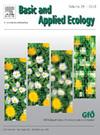Temporal stability of agricultural land-use effects on morphological traits and abundance in bumblebees and syrphid flies
IF 3.5
2区 环境科学与生态学
Q2 ECOLOGY
引用次数: 0
Abstract
Pollinator populations are globally declining due to environmental and anthropogenic stressors, especially in agricultural areas. Land-use intensification and its consequences can shape both abundance and functional traits in pollinators, which may reduce pollination, and thus threaten ecosystem functioning. This study investigates temporal stability of land-use and climatic effects on morphological traits and abundance of the bumblebee Bombus lapidarius and the syrphid fly Episyrphus balteatus in agricultural grasslands. As responses, we measured body size and asymmetry using wing centroid sizes of specimen sampled in the years 2008, 2012 and 2020 and assessed the relative abundance of the two species. By using a variety of environmental variables on local and landscape-scale, reflecting land-use intensity and floral resource availability for pollinators, we were interested in the individual effects of the stressors, but particularly whether the effects are stable across the three sampling years. The body size of bumblebees decreased with local land-use intensity and increased with local availability of floral resources. In contrast the body size of syrphid flies decreased with landscape-level land-use and strongly depended on temperature. Bumblebee abundance declined with local land-use intensity, while syrphid flies were more abundant on plots with higher local land-use. The effects of most land-use stressors on both pollinator morphology and abundance showed consistent patterns across the three sampling years, except for local land-use and climatic factors, which showed significant interactive effects with the sampling year on the morphology of both species. Our results indicate that land-use effects on pollinators are stable over time and demonstrate that pollinators may be under persistent pressure of land-use in agricultural areas.
农业土地利用对大黄蜂和蚜蝇形态特征和丰度影响的时间稳定性
由于环境和人为压力因素,传粉媒介的数量在全球范围内下降,特别是在农业地区。土地利用集约化及其后果可以影响传粉媒介的丰度和功能特征,从而可能减少传粉,从而威胁到生态系统的功能。研究了农业草原土地利用和气候变化对大黄蜂和刺蚜蝇形态特征和丰度的影响。作为回应,我们利用2008年、2012年和2020年采样的标本的翅膀质心大小测量了身体大小和不对称性,并评估了两种物种的相对丰度。通过在当地和景观尺度上使用各种环境变量,反映土地利用强度和传粉媒介的花卉资源可用性,我们对压力源的个体影响感兴趣,但特别是在三个采样年的影响是否稳定。大黄蜂的体型随当地土地利用强度的增大而减小,随当地花卉资源的可利用性的增大而增大。蝇体大小随土地利用程度的不同而减小,且受温度的影响较大。随着土地利用强度的增加,大黄蜂的丰度呈下降趋势,而在土地利用强度越高的地块,蚜蝇的丰度越高。除了当地土地利用和气候因子与取样年份存在显著的交互作用外,大部分土地利用胁迫因子对传粉昆虫形态和丰度的影响在3个取样年之间表现出一致的模式。研究结果表明,土地利用对传粉媒介的影响随时间的推移是稳定的,表明农区传粉媒介可能受到土地利用的持续压力。
本文章由计算机程序翻译,如有差异,请以英文原文为准。
求助全文
约1分钟内获得全文
求助全文
来源期刊

Basic and Applied Ecology
环境科学-生态学
CiteScore
6.90
自引率
5.30%
发文量
103
审稿时长
10.6 weeks
期刊介绍:
Basic and Applied Ecology provides a forum in which significant advances and ideas can be rapidly communicated to a wide audience. Basic and Applied Ecology publishes original contributions, perspectives and reviews from all areas of basic and applied ecology. Ecologists from all countries are invited to publish ecological research of international interest in its pages. There is no bias with regard to taxon or geographical area.
 求助内容:
求助内容: 应助结果提醒方式:
应助结果提醒方式:


